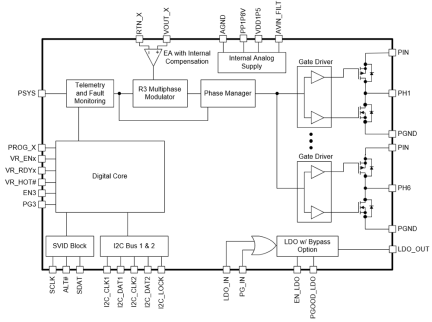Overview
Description
The RAA225019 is a highly configurable PMIC for Intel IMVP9.2 Lunar Lake applications. It features fully integrated power MOSFETs, controllers, and current-sensing circuitry, and adopts high switching frequency for high power-density and efficiency for small form factor design.
Six phases can be distributed across three outputs (two SVID rails and one auxiliary rail). The SVID1 rail operates from a max phase count of 2 to 6 while the SVID2 and BUCK3 rails can run either a 1-phase or 2-phase configuration. Additionally, the device contains an integrated LDO with a Power Gate bypass option.
The PMIC uses the Renesas Robust Ripple Regulator technology with its many advantages as compared to traditional modulation schemes. Output capacitance requirements are minimized because of fast transient settling time and a variable switching frequency in response to load transients. Light load efficiency is boosted through APM and auto-DCM with natural period stretching at low load currents, benefiting standby battery life.
Features
- WLCSP package of 12×9 ball array in 0.4mm pitch, approximately 5.04mm×3.74mm in size
- Total height of 0.525mm including solder balls supporting ultra-low-profile design
- Input voltage range from 2.7V to 4.5V
- Integrated FETs and current sensing for small form factor designs
- 6 phases configurable over 3 outputs - 2 SVID rails and 1 auxiliary rail
- Integrated LDO with a power gate bypass option
- Switching Frequency of 2MHz across rails, supporting small form factor chip inductor
- Cycle-by-cycle current limiting feature supports Fast V-Mode (FVM) operation
- Automatic phase add/drop for optimal efficiency over the entire load current range
- Output current, temperature, and PSYS telemetry available through SVID and I2C Bus
Comparison
Applications
- Low power mobile devices
Documentation
|
|
|
|
|---|---|---|
| Type | Title | Date |
| Datasheet | PDF 2.49 MB | |
| Application Note | PDF 198 KB | |
2 items
|
||
Design & Development
Models
ECAD Models
Schematic symbols, PCB footprints, and 3D CAD models from SamacSys can be found by clicking on products in the Product Options table. If a symbol or model isn't available, it can be requested directly from the website.

Product Options
Applied Filters:
